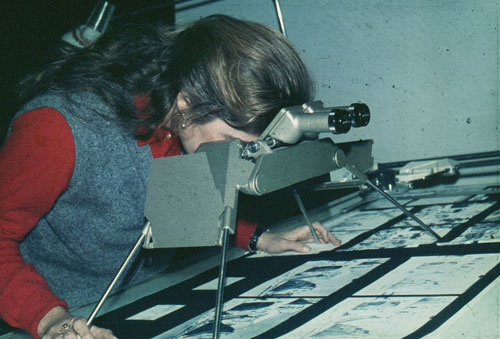Polytechnic of Bari (Italy)
Architectural Photogrammetry Laboratory
Stereoscopic vision

The visible relief, through the use of the photographic image, is possible only on condition that it is observed with only one eye, placed in the point corresponding to the center of projection: only in these conditions, when observing the photograph, the The visual axis of our eye reconstructs the beam of rays that has projected it. Failure to comply with this condition is the basis of the reputation of "great liar" of which the camera is a victim.  Looking at the photo shown here, on the left, we manage to give dimensions to the steps, to the door, to the wall blocks etc., based on our cultural background, but we will certainly be amazed when, observing the image of the same door, shown on the right , we will discover that we were wrong, seeing at the bottom right an element of sure metric reference, what is the image of a man.
Looking at the photo shown here, on the left, we manage to give dimensions to the steps, to the door, to the wall blocks etc., based on our cultural background, but we will certainly be amazed when, observing the image of the same door, shown on the right , we will discover that we were wrong, seeing at the bottom right an element of sure metric reference, what is the image of a man.
 When we talk about three-dimensional or stereo photography, we always refer to a pair of frames (taken from two distinct points), whose simultaneous observation offers the perception of the three-dimensional image of the photographed object. There are many methods that man uses to observe the three-dimensional photographic image: some require more or less sophisticated instruments, others a simple training. Here, however, we are primarily concerned with understanding the mechanism our brain uses when performing dimensional analysis. Let's start by examining the optical apparatus, that is, the eye, whose operation is often assimilated to that of a camera: in fact, it is a particular darkroom equipped with a lens (crystalline), a diaphragm (iris) and a sensitive surface (retina); however, the shutter and the possibility to fix the image are missing, so if we think about it we could compare the eye to a camera, but there is still another feature that we cannot absolutely overlook and it is the continuous mobility of the same . In reality, the sensitivity of the retina is not uniform and is maximum in a particular point (fovea), which, thanks to the possibility of rotation of the eyeball, is continuously moved to the most interesting areas of the projected image. The projecting ray passing through it is called visual axis. In making the dimensional analysis of any object, the brain uses different methods of survey: perspective, comparison of the two images projected on the retina and triangulation. Of the three, the first two essentially serve to identify the elements to be analyzed, while the third detects the position of the points observed by means of an authentic triangulation based on the distance between the centers of rotation of the eyeballs and on the vertex the intersection of the axes visual. In truth, it is not that the brain measures, for each point, the angles formed by the visual axes with the base and performs the relative calculations to derive the three coordinates in an orthogonal Cartesian reference system, but continuously stores the data after having subjected them to occurs. For example, in the first months of life, before being able to take an object, the child must develop his own survey program. Provided that both eyes are functional, before starting the gripping operations, he must identify the position of the object that interests him and to do this he can:
When we talk about three-dimensional or stereo photography, we always refer to a pair of frames (taken from two distinct points), whose simultaneous observation offers the perception of the three-dimensional image of the photographed object. There are many methods that man uses to observe the three-dimensional photographic image: some require more or less sophisticated instruments, others a simple training. Here, however, we are primarily concerned with understanding the mechanism our brain uses when performing dimensional analysis. Let's start by examining the optical apparatus, that is, the eye, whose operation is often assimilated to that of a camera: in fact, it is a particular darkroom equipped with a lens (crystalline), a diaphragm (iris) and a sensitive surface (retina); however, the shutter and the possibility to fix the image are missing, so if we think about it we could compare the eye to a camera, but there is still another feature that we cannot absolutely overlook and it is the continuous mobility of the same . In reality, the sensitivity of the retina is not uniform and is maximum in a particular point (fovea), which, thanks to the possibility of rotation of the eyeball, is continuously moved to the most interesting areas of the projected image. The projecting ray passing through it is called visual axis. In making the dimensional analysis of any object, the brain uses different methods of survey: perspective, comparison of the two images projected on the retina and triangulation. Of the three, the first two essentially serve to identify the elements to be analyzed, while the third detects the position of the points observed by means of an authentic triangulation based on the distance between the centers of rotation of the eyeballs and on the vertex the intersection of the axes visual. In truth, it is not that the brain measures, for each point, the angles formed by the visual axes with the base and performs the relative calculations to derive the three coordinates in an orthogonal Cartesian reference system, but continuously stores the data after having subjected them to occurs. For example, in the first months of life, before being able to take an object, the child must develop his own survey program. Provided that both eyes are functional, before starting the gripping operations, he must identify the position of the object that interests him and to do this he can:
- use the perspective; but he must have already memorized the dimensions of the object observed, otherwise he will believe that he has an airplane at hand, which appears small only because it is very far away;
- use stereoscopy; but he must have acquired enough experience to be able to establish the distance of an object on the basis of the different width of the two images projected on the retina of his eyes;
- perform triangulation; but must have already memorized the law of variation of the angle formed by the visual axes as a function of the distance of the observed point.
Obviously, the survey program is not elaborated by the brain on the basis of mathematical calculations or graphic representations, but rather with a series of attempts whose results constitute the indispensable database for any new experience. When new situations arise, our brain returns to behave like that of the child; to convince ourselves, let's try a simple experiment, asking one of our interlocutors to place the tip of a pencil on that of a similar one, which we hold in hand at the height of his eyes. If the person undergoing the experiment keeps both eyes open, he will have no difficulty touching the tip with his pencil, but if we ask him to keep one eye closed, he will have to make several attempts to perform the operation. After the first failures he will try to observe the pencil (and therefore to detect its position) with both eyes before closing one to repeat the attempt, or he will move the pencil along its visual axis until it meets the other: in short, its behavior will not be very different from that of the child. If we still want to undermine our interlocutor's detection system, we can ask him to rest the tip of the pencil on a wire that we will take care to stretch to the height of his eyes in the plane of the visual axes. Even in this case, despite the use of binocular vision, his brain is unable to triangulate: in fact, the uniform surface of the wire does not allow him to identify a particular point on which to converge the visual axes, the angle of which is indispensable for determine the distance. If, on the other hand, we arrange the thread vertically, our interlocutor will have no difficulty: in fact, accustomed as he is to maintaining the coplanarity of the visual axes, he will make them converge easily on the intersection point of the thread with the plane they have determined.
1. The artificial stereo vision.
If in the analysis of any object we place before the eyes, at the minimum viewing distance, a transparent glass plate, the visual rays will describe on it two perspective images identical to those obtainable with a camera, equipped with two lenses, distant reciprocally as much as our interpupillary distance, having a focal distance equal to the distance of the plate from our eyes or, more precisely, a main distance equal respectively to the distance of the centers of rotation of the two eyeballs from the plate itself. By replacing the direct image of the object with the two slides obtained, arranged appropriately on our glass plate and viewed separately but simultaneously, our brain will perceive a three-dimensional image. It will be all the more faithful to the original the more faithful the reconstruction, during the observation phase, of the two bundles of straight lines consisting of all the positions assumed by the visual axes in the analysis of the object.
2. The three-dimensional optical model.
If the two bundles of straight lines, determined by the visual axes being recorded, do not coincide with those identified in the observation of the stereo pair of frames, the image perceived by the brain will differ from the original. Often, however, recourse is made to a suitable variation of the observation conditions with respect to the shooting conditions. The reconstruction of the image, commonly called the three-dimensional optical model, is deformed or simply reduced to make dimensional analysis easier. To analyze, for example, the deformations of a flat surface we can simply increase, in the observation phase, the main distance exasperating any convexities or concavities present. By increasing, on the other hand, the shooting base compared to the observation base, we can reduce the optical model to scale or, vice versa, enlarge it at will: an application of this principle is in stereophotogrammetry, where the base / shooting distance ratio is contained in the 1/5 - 1/20 interval to allow dimensional analysis in optimal conditions.